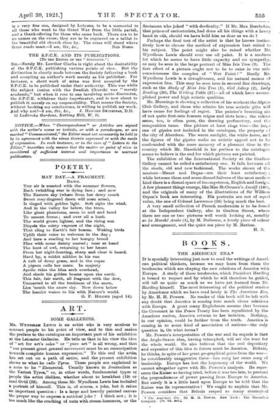ART.
SOME GALLF,RIES.
Ma. WYNDHAM LEWIS is an artist who is very anxious to convert people to his point of view, and to this end makes the preface to the catalogue an important part of his exhibition at the Leicester Galleries. He tells us that in his view the idea of " art for art's sake " or " pure art " is all wrong, and that " our present great general movement must be an emancipation towards complete human expression." To this end the artist has set out on a path of satire, and the present exhibition shows us what he calls Tyros. These people are explained in a note to be " Elemental Usually known in Journalism as the Veriest Tyros," or, in other words, fundamental types of People the artist dislikes, whether about to breakfast (19) or read Ovid (26). Among these Mr. Wyndham Lewis has included a portrait of himself. This is, of course, a joke, but it raises an important question : Is a large and heavily painted canvas the proper way to express a satirical joke ? I think not ; it is too much like the cracking of nuts with steam-hammers, or the
Scotsman who joked " with deeficulty." If Mr. Max Beerbohm, that prince of caricaturists, had done all his things with a heavy hand in oils, should we have held him as dear as we do ?
Perhaps the final test of the artist is that he knows instinc- tively how to choose the method of expression best suited to his subject. The point might also be raised whether Mr. Wyndham Lewis should ever use oil paint. It is a medium for which he seems to have little capacity and no sympathy, as may be seen in the large portrait of Miss Iris Tree (9). The first effect of a picture ought not to be to raise in our sub- consciousness the complex of " Wet Paint ! " Really Mr. Wyndham Lewis is a draughtsman, and his natural moans of expression line. This may be seen here in several fine drawings, such as the Study of Miss Iris Tree (1), Girl "Weep (2), Lady Reading (30), The Writing Table (37)—all of which have accom- plished power and high artistic qualities.
Mr. Munnings is showing a collection of his works at the Alpine Club Gallery, and those who admire his true artistic gifts will have cause for feelings of regret. The painter's besetting sin of not quite first-rate bravura reigns and riots hero ; the colour sense, too, is often poor, the drawing perfunctory, and the composition tame. One picture at least rings true—the largo one of gipsios not included in the catalogue, the property c f the city of Aberdeen. The warm sunlight, the white horse, and the figures of the gipsies make an artistic appeal not to be confounded with the mere memory of a pleasant time in the country which Mr. Masefield in his preface to the catalogue seems to believe is the end for which pictures are painted.
The exhibition of the International Society at the Grafton Gallery cannot be called a satisfactory one. It falls between all the stools, old and new fashioned. The works shown of the masters—Manet and Degas—are their least satisfactory ; while between these and some dismal failures of the most modern kind there is a dismal space of incompetence, English and foreign. A few pleasant things emerge, like Miss McCrossan's Amalfi (140), and the originals of many of the illustrations of Sir William Orpen's book are interesting. His portraits are not of equal value, the one of Colonel Lawrence (20) being much the best.
A very small collection of French modernists is to be found at the Independent Gallery, also in Grafton Street, whero there are one or two pictures well worth looking at, notably so Le MaraM Arabs (1), by M. Dufresne, a lovely piece of colour and arrangement, and the quiet sea piece by M. Matisse.
H. S.


































 Previous page
Previous page